Categories
Archives
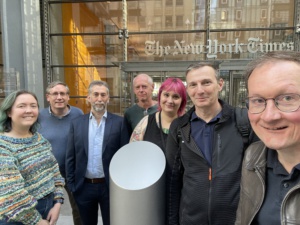
Last week, the IPTC Spring Meeting 2024 brought media industry experts together for three days in New York City to discuss many topics including AI, archives and authenticity.
Hosted by both The New York Times and Associated Press, over 50 attendees from 14 countries participated in person, with another 30+ delegates attending online.
As usual, the IPTC Working Group leads presented a summary of their most recent work, including a new release of NewsML-G2 (version 2.34, which will be released very soon); forthcoming work on ninjs to support events, planned news coverage and live streamed video; updates to NewsCodes vocabularies; more evangelism of IPTC Sport Schema; and further work on Video Metadata Hub, the IPTC Photo Metadata Standard and our emerging framework for a simple way to express common rights statements using RightsML.
We were very happy to hear many IPTC member organisations presenting at the Spring Meeting. We heard from:
- Anna Dickson of recently-joined member Google talked about their work with IPTC in the past and discussed areas where we could collaborate in the future
- Aimee Rinehart of Associated Press presented AP’s recent report on the use of generative AI in local news
- Scott Yates of JournalList gave an update on the trust.txt protocol
- Andreas Mauczka, Chief Digital Officer at Austria Press Agency APA presented on APA’s framework for use of generative AI in their newsroom
- Drew Wanczowski of Progress Software gave a demonstration of how IPTC standards can be implemented in Progress’s tools such as Semaphore and MarkLogic
- Vincent Nibart and Geert Meulenbelt of new IPTC Startup Member Kairntech presented on their recent work with AFP on news categorisation using IPTC Media Topics and other vocabularies
- Mathieu Desoubeaux of IPTC Startup Member IMATAG presented their work, also with AFP, on watermarking images for tracking and metadata retrieval purposes
In addition we heard from guest speakers:
- Jim Duran of the Vanderbilt TV News Archive spoke about how they are using AI to catalog and tag their extensive archive of decades of broadcast news content
- John Levitt of Elvex spoke about their system which allows media organisations to present a common interface (web interface and developer API) to multiple generative AI models, including tracking, logging, cost monitoring, permissions and other governance features which are important to large organisations using AI models.
- Toshit Panigrahi, co-founder of TollBit spoke about their platform for “AI content licensing at scale”, allowing content owners to establish rules and monitoring around how their content should be licensed for both the training of AI models and for retrieval-augmented generation (RAG)-style on-demand content access by AI agents.
- We also heard an update about the TEMS – Trusted European Media Data Space project.
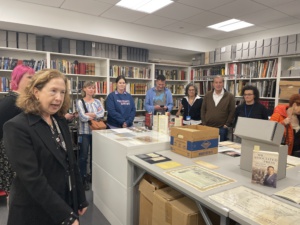 We were also lucky enough to take tours of the Associated Press Corporate Archive on Tuesday and the New York Times archive on Wednesday. Valierie Komor of AP Corporate Archives and Jeff Roth of The New York Times Archival Library (known to staffers as “the morgue”) both gave fascinating insights and stories about how both archives preserve the legacy of these historically important news organisations.
We were also lucky enough to take tours of the Associated Press Corporate Archive on Tuesday and the New York Times archive on Wednesday. Valierie Komor of AP Corporate Archives and Jeff Roth of The New York Times Archival Library (known to staffers as “the morgue”) both gave fascinating insights and stories about how both archives preserve the legacy of these historically important news organisations.
Brendan Quinn, speaking for Judy Parnall of the BBC, also presented an update of the recent work of C2PA and Project Origin and introduced the new IPTC Media Provenance Committee, dedicated to bringing C2PA technology to the news and media industry.
On behalf all attendees, we would like to thank The New York Times and Associated Press for hosting us, and especially to thank Jennifer Parrucci of The New York Times and Heather Edwards of The Associated Press for their hard work in coordinating use of their venues for our meeting.
The next IPTC Member Meeting will be the 2024 Autumn Meeting, which will be held online from Monday September 30th to Wednesday October 2nd, and will include the 2024 IPTC Annual General Meeting. The Spring Meeting 2025 will be held in Western Europe at a location still to be determined.

The International Press Telecommunications Council, in conjunction with Project Origin, has established a working group to create and manage a C2PA compatible list of verified news publishers.
The open C2PA 2.0 Content Credentials standard for media provenance is widely supported as a strong defence against misinformation. Recent announcements by OpenAI, Meta, Google and others have confirmed the value of an interoperable, tamper-evident way of confirming the source and technical integrity of digital media content.
Project Origin, as a co-founder of the C2PA, has brought the needs of the news publishing community to the forefront of the creation of this standard. This now includes the creation of a C2PA 2.0 compatible Origin Verified Publisher Certificate to be used by publishers to securely create a cryptographic seal on their content. The signing certificates will be available through the IPTC, who will work with C2PA validators to gain widespread acceptance. These signing certificates will be issued by the IPTC to broadcast, print and digital native media publishers.
Origin Verified Publisher Certificates will ensure that the identity of established news organisations are protected from imposters. The certificates confirm organisational identity and do not make any judgement on editorial position. Liaison agreements with other groups in the media ecosystem will be used to accelerate the distribution of certificates.
The initial implementation uses TruePic as a certificate authority, with the BBC and CBC/Radio-Canada as trial participants.
“As a founding partner of Project Origin, CBC/Radio-Canada is proud to be one of the first media organisations to trial Origin Verified Publisher Certificates,” said Claude Galipeau, Executive Vice-President, Corporate Development, CBC/Radio-Canada. “This initiative will provide our audiences with a new and easy way of confirming that the content they’re consuming is legitimately from Canada’s national public broadcaster. It’s an important step in our adoption of the Content Credentials standard and in our fight against misinformation and disinformation.”
Jatin Aythora, Director of BBC R&D, and vice chair for Partnership on AI, said “Media provenance increases trust and transparency in news, and so is an essential tool in the fight against disinformation. That fight has never been more important, and so we hope many more media organisations will join us in securing their own Origin Verified Publisher Certificate.”
Publishers interested in working cooperatively to advance the implementation of the C2PA standard in the news ecosystem are invited to join the Media Provenance Committee of the IPTC.
For further information please contact:
- Judy Parnall – judy.parnall@bbc.co.uk – representing the BBC
- Bruce MacCormack – bruce@neuraltransform.com – representing CBC/Radio-Canada
- Brendan Quinn – mdirector@iptc.org – representing the IPTC
The 2024 IPTC Photo Metadata Conference takes place as a webinar on Tuesday 7th May from 1500 – 1800 UTC. Speakers hail from Adobe (makers of Photoshop), CameraBits (makers of PhotoMechanic), Numbers Protocol, Colorhythm, vAIsual and more.
First off, IPTC Photo Metadata Working Group co-leads, David Riecks and Michael Steidl, will give an overview of what has been happening in the world of photo metadata since our last Conference in November 2022, including IPTC’s work on metadata for AI labelling, “do not train” signals, provenance, diversity and accessibility.
Next, a panel session on AI and Image Authenticity: Bringing trust back to photography? discusses approaches to the problem of verifying trust and credibility for online images. The panel features C2PA lead architect Leonard Rosenthol (Adobe), Dennis Walker (Camera Bits), Neal Krawetz (FotoForensics) and Bofu Chen (Numbers Protocol).
Next, James Lockman of Adobe presents the Custom Metadata Panel, which is a plugin for Photoshop, Premiere Pro and Bridge that allows for any XMP-based metadata schema to be used – including IPTC Photo Metadata and IPTC Video Metadata Hub. James will give a demo and talk about future ideas for the tool.
Finally, a panel on AI-Powered Asset Management: Where does metadata fit in? discusses teh relevance of metadata in digital asset management systems in an age of AI. Speakers include Nancy Wolff (Cowan, DeBaets, Abrahams & Sheppard, LLP), Serguei Fomine (IQPlug), Jeff Nova (Colorhythm) and Mark Milstein (vAIsual).
The full agenda and links to register for the event are available at https://iptc.org/events/photo-metadata-conference-2024/
Registration is free and open to anyone who is interested.
See you there on Tuesday 7th May!
The IPTC Photo Metadata Working Group has updated the IPTC Photo Metadata User Guide, including guidance for accessibility and for tagging AI-generated images with metadata.
The updates to the User Guide are across several areas:
- A guide to using the accessibility fields added in IPTC Photo Metadata Standard version 2021.1 (Alt Text (Accessibility) and Extended Description (Accessibility) has been added
-
A new section with guidance for applying metadata to AI-generated images has been added
-
Guides for new fields added: Event Identifier, Product/Identifier, Contributor, Data Mining
-
The Metadata Usage Examples section has been updated to reflect some of the recently-added fields
-
The guidance on fields and topics has generally been reviewed and updated
Please let us know if you spot any other areas of the user guide that should be updated or if you have suggestions for more guidance that we could give.
 After many years of working together in various areas related to media metadata, IPTC, the global technical standards body of the news media, today announces that Google LLC has joined IPTC as a Voting Member.
After many years of working together in various areas related to media metadata, IPTC, the global technical standards body of the news media, today announces that Google LLC has joined IPTC as a Voting Member.
As a Voting Member, Google will take part in all decisions regarding IPTC standards and delegates will contribute to shaping the standards as they evolve. This important work will happen alongside IPTC’s 26 other Voting Member companies.
“Google has worked with IPTC standards for many years, so it is great to see them join IPTC so that they can take part in shaping those standards in the future,” said Robert Schmidt-Nia of DATAGROUP, Chair of the Board of IPTC. “We look forward to working together with Google on our shared goals of making information usable and accessible.”
“Google has a long history of working with the IPTC, and we are very happy to now have joined the organization,” Anna Dickson, Product Manager at Google, said. “Joining aligns with our efforts to help provide more information and context to people online. We think this is critical to increasing trust in the digital ecosystem as AI becomes more ubiquitous.”
Google’s work together with IPTC started back in 2010 when schema.org, a joint project managed by Google on behalf of search engines, adopted IPTC’s rNews schema as the basis for schema.org’s news properties such as NewsArticle and CreativeWork. In 2016, the IPTC was a recipient of a Google News Initiative grant to develop the EXTRA rules-based metadata classification engine.
Google staff spoke at the Photo Metadata Conference (co-hosted with CEPIC) in 2018, which led to Google and the IPTC working together (along with CEPIC) on adding support for copyright, credit and licensing information in Google image search results. This has continued to include support for the Digital Source Type property which will now be used to signal content created by Generative AI engines.
The latest update to IPTC NewsCodes, the 2024-Q1 release, was published on Thursday 28th March.
This release includes many updates to our Media Topic subject vocabulary, plus changes to Content Production Party Role, Horse Position, Tournament Phase, Soccer Position, Genre, User Action Type and Why Present.
UPDATE on 11 April: we released a small update to the Media Topics, including Norwegian (no-NB and no-NN) translations of the newly added terms, thanks to Norwegian news agency NTB.
We also made one label change in German: medtop:20000257 from “Alternative-Energie” to “Erneuerbare Energie,” This change was made at the request of German news agency dpa.
Changes to Media Topics vocabulary
As part of the regular review undertaken by the NewsCodes Working Group, many changes were made to the economy, business and finance branch of Media Topics. In addition, a number of changes were made to the conflict, war and peace branch in response to suggestions made by new IPTC member ABC Australia.
5 new concepts: sustainability, profit sharing, corporate bond, war victims, missing in action.
12 retired concepts: justice, restructuring and recapitalisation, bonds, budgets and budgeting, consumers, consumer issue, credit and debt, economic indicator, government aid, investments, prices, soft commodities market.
55 modified concepts: peacekeeping force, genocide, disarmament, prisoners of war, war crime, judge, economy, economic trends and indicators, business enterprise, central bank, consumer confidence, currency, deflation, economic growth, gross domestic product, industrial production, inventories, productivity, economic organisation, emerging market, employment statistics, exporting, government debt, importing, inflation, interest rates, international economic institution, international trade, trade agreements, balance of trade, trade dispute, trade policy, monetary policy, mortgages, mutual funds, recession, tariff, market and exchange, commodities market, energy market, debt market, foreign exchange market, loan market, loans and lending, study of law, disabilities, mountaineering, sport shooting, sport organisation, recreational hiking and climbing, start-up and entrepreneurial business, sharing economy, small and medium enterprise, sports officiating, bmx freestyle.
48 concepts with modified names/labels: judge, emergency incident, transport incident, air and space incident, maritime incident, railway incident, road incident, restructuring and recapitalisation, economic trends and indicators, exporting, importing, interest rates, balance of trade, mortgages, commodities market, soft commodities market, loans and lending, study of law, disabilities, mountain climbing, mountaineering, sport shooting, sport organisation, recreational hiking and climbing, start-up and entrepreneurial business, sports officiating, bmx freestyle, tsunami, healthcare industry, developmental disorder, depression, anxiety and stress, public health, pregnancy and childbirth, fraternal and community group, cyber warfare, public transport, taxi and ride-hailing, shared transport, business reporting and performance business restructuring commercial real estate residential real estate podcast, financial service, business service, news industry, diversity, equity and inclusion.
57 modified definitions: war crime, economy, economic trends and indicators, business enterprise, central bank, consumer confidence, currency, deflation, economic growth, economic organisation, emerging market, employment statistics, exporting, government debt, importing, inflation, interest rates, international economic institution, trade agreements, trade dispute, trade policy, mortgages, recession, tariff, market and exchange, commodities market, energy market, soft commodities market, debt market, foreign exchange market, loan market, loans and lending, disabilities, mountaineering, sport organisation, start-up and entrepreneurial business, sharing economy, small and medium enterprise, tsunami, healthcare industry, developmental disorder, depression, anxiety and stress, public health, pregnancy and childbirth, cyber warfare, public transport, taxi and ride-hailing, shared transport, business reporting and performance, business restructuring, commercial real estate, residential real estate, podcast, financial service, business service, news industry.
22 modified broader terms (hierarchy moves): peacekeeping force, genocide, disarmament, prisoners of war, business enterprise, central bank, consumer confidence, currency, gross domestic product, industrial production, inventories, productivity, economic organisation, emerging market, interest rates, international economic institution, international trade, monetary policy, mutual funds, tariff, loans and lending, bmx freestyle.
These changes are already available in the en-GB, en-US and Swedish (se) language variants. Thanks go to TT and Bonnier News for their work on the Swedish translation.
If you would like to contribute or update a translation to your language, please contact us.
Sports-related NewsCodes updates
We also made some changes to our sports NewsCodes vocabularies, which are mostly used by SportsML and IPTC Sport Schema.
New vocabulary: Horse Position
New entries in Tournament Phase vocabulary: Heat, Round of 16
New entry in Soccer Position: manager,
News-related NewsCodes updates
Content Production Party Role: new term Generative AI Prompt Writer which can also be used in Photo Metadata Contributor to declare who wrote the prompt that was used to generate an image.
Genre: new term User-Generated Content.
Why Present: new term associated.
The User Action Type vocabulary, mostly used by NewsML-G2, has had some major changes.
Previously this vocabulary defined terms related to specific social media services or interactions. We have retired/deprecated all site-specific terms (Facebook Likes, Google’s +1, Twitter re-tweets, Twitter tweets).
Instead, we have defined some generic terms: Like, Share, Comment. The pageviews term has been broadened into simply views (although the ID remains as “pageviews” for backwards-compatibility)
Thanks to the NewsCodes Working Group for their work on this release, and to all members and non-members who have suggested changes.
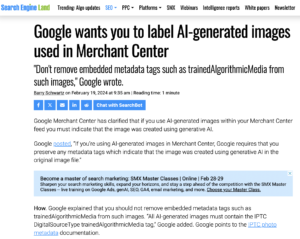
Google has added Digital Source Type support to Google Merchant Center, enabling images created by generative AI engines to be flagged as such in Google’s products such as Google search, maps, YouTube and Google Shopping.
In a new support post, Google reminds merchants who wish their products to be listed in Google search results and other products that they should not strip embedded metadata, particularly the Digital Source Type field which can be used to signal that content was created by generative AI.
We at the IPTC fully endorse this position. We have been saying for years that website publishers should not strip metadata from images. This should also include tools for maintaining online product inventories, such as Magento and WooCommerce. We welcome contact from developers who wish to learn more about how they can preserve metadata in their images.
Here’s the full text of Google’s recommendation:
The IPTC News Architecture Working Group is happy to announce that the NewsML-G2 Guidelines and NewsML-G2 Specification documents have been updated to align with version 2.33 of NewsML-G2, which was approved in October 2023.
The changes include:
Specification changes:
- Adding the newest additions authoritystatus and digitalsourcetype added in NewsML-G2 versions 2.32 and 2.33
- Clarification on how @uri, @qcode and @literal attributes should be treated throughout
- Clarification on how roles should be added to infosource element when an entity plays more than one role
- Clarifying and improving cross-references and links throughout the document
Guidelines changes:
- Documentation of the Authority Status attrribute and its related vocabulary, added in version 2.32
- Documentation of the Digital Source Type element and its related vocabulary, added in version 2.33
- Clarification on how @uri, @qcode and @literal attributes should be treated throughout
- Clarifying and improving cross-references and links throughout the document
- Improved the additional resources section including links to related IPTC standards and added links to the SportsML-G2 Guidelines
- See the What’s New in NewsML-G2 2.32 and 2.33 section for full details.
We always welcome feedback on our specification and guideline documents: please use the Contact Us form to ask for clarifications or suggest changes.

Yesterday Nick Clegg, Meta’s President of Global Affairs, announced that Meta would be using IPTC embedded photo metadata to label AI-Generated Images on Facebook, Instagram and Threads.
Meta already uses the IPTC Photo Metadata Standard’s Digital Source Type property to label images generated by its platform. The image to the right was generated using Imagine with Meta AI, Meta’s image generation tool. Viewing the image’s metadata with the IPTC’s Photo Metadata Viewer tool shows that the Digital Source Type field is set to “trainedAlgorithmicMedia” as recommended in IPTC’s Guidance on metadata for AI-generated images.
Clegg said that “we do several things to make sure people know AI is involved, including putting visible markers that you can see on the images, and both invisible watermarks and metadata embedded within image files. Using both invisible watermarking and metadata in this way improves both the robustness of these invisible markers and helps other platforms identify them.”
This approach of both direct and indirect disclosure is in line with the Partnership on AI’s Best Practices on signalling the use of generative AI.
Also, Meta are building recognition of this metadata into their tools: “We’re building industry-leading tools that can identify invisible markers at scale – specifically, the “AI generated” information in the C2PA and IPTC technical standards – so we can label images from Google, OpenAI, Microsoft, Adobe, Midjourney, and Shutterstock as they implement their plans for adding metadata to images created by their tools.”
We have previously shared the news that Google, Microsoft, Adobe, Midjourney and Shutterstock will use IPTC metadata in their generated images, either directly in the IPTC Photo Metadata block or using the IPTC Digital Source Type vocabulary as part of a C2PA assertion. OpenAI has just announced that they have started using IPTC via C2PA metadata to signal the fact that images from DALL-E are generated by AI.
A call for platforms to stop stripping image metadata
We at the IPTC agree that this is a great step towards end-to-end support of indirect disclosure of AI-generated content.
As the Meta and OpenAI posts points out, it is possible to strip out both IPTC and C2PA metadata either intentionally or accidentally, so this is not a solution to all problems of content credibility.
Currently, one of the main ways metadata is stripped from images is when they are uploaded to Facebook or other social media platforms. So with this step, we hope that Meta’s platforms will stop stripping metadata from images when they are shared – not just the fields about generative AI, but also the fields regarding accessibility (alt text), copyright, creator’s rights and other information embedded in images by their creators.
Video next?
Meta’s post indicates that this type of metadata isn’t commonly used for video or audio files. We agree, but to be ahead of the curve, we have added Digital Source Type support to IPTC Video Metadata Hub so videos can be labelled in the same way.
We will be very happy to work with Meta and other platforms on making sure IPTC’s standards are implemented correctly in images, videos and other areas.
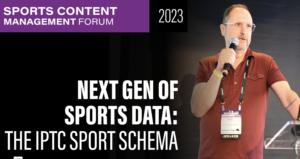
As we wrap up 2023, we thought it would be useful to give an update you on the IPTC’s work in 2023, including updates to most of our standards.
Two successful member meetings, one in person!
This year we finally held our first IPTC Member meeting in person since 2019, in Tallinn Estonia. We had around 30 people attend in person and 50 attended online from over 40 organisations. Presentations and discussions ranged from the e-Estonia digital citizen experience to building re-usable news content widgets with Web Components, and of course included generative AI, credibility and fact checking, and more. Here’s our report on the IPTC 2023 Spring Meeting.
For our Autumn Meeting we went back to an online format, with over 50 attendees, and more watching the recordings afterwards (which are available to all members). Along with discussions of generative AI and content licensing at this year’s meetings, it was great to hear the real-world implementation experience of the ASBU Cloud project from the Arab States Broadcasting Union. The system was created by IPTC members Broadcast Solutions, based on NewsML-G2. The DPP Live Production Exchange, led by new members Arqiva, will be another real-world implementation coming soon. We heard about the project’s first steps at the Autumn Meeting.
Also at this years Autumn Meeting we also heard from Will Kreth of the HAND Identity platform and saw a demo of IPTC Sport Schema from IPTC member Progress Software (previously MarkLogic). More on IPTC Sport Schema below! All news from the Autumn Meeting is summed up in our post AI, Video in the cloud, new standards and more: IPTC Autumn Meeting 2023
We’re very happy to say that the IPTC Spring Meeting 2024 will be held in New York from April 15 – 17. All IPTC member delegates are welcome to attend the meeting at no cost. If you are not a member but would like to present your work at the meeting, please get in touch using our Contact Us form.
IPTC Photo Metadata Conference, 7 May 2024: save the date!
Due to several issues, we were not able to run a Photo Metadata Conference in 2023, but we will be back with an online Photo Metadata Conference on 7th May 2024. Please mark the date in your calendar!
As usual, the event will be free and open for anyone to attend.
If you would like to present to the people most interested in photo metadata from around the world, please let us know!
Presentations at other conferences and work with other organisations
IPTC was represented at the CEPIC Congress in France, the EBU DataTech Seminar in Geneva, Sports Video Group Content Management Forum in New York and the DMLA’s International Digital Media Licensing Conference in San Francisco.
We also worked with CIPA, the organisation behind the Exif photo metadata standard, on aligning Exif with IPTC Photo Metadata, and supported them in their work towards Exif 3.0 which was announced in June.
The IPTC will be advising the TEMS project which is an EU-funded initiative to build a “media data space” for Europe, and possibly beyond: IPTC working with alliance to build a European Media Data Space.
IPTC’s work on Generative AI and media
Of course the big topic for media in 2023 has been Generative AI. We have been looking at this topic for several years, since it was known as “synthetic media” and back in 2022 we created a taxonomy of “digital source types” that can be used to describe various forms of machine-generated and machine-assisted content creation. This was a joint effort across our NewsCodes, Video Metadata and Photo Metadata Working Groups.

It turns out that this was very useful, and the IPTC Digital Source Type taxonomy has been adopted by Google, Midjourney, C2PA and others as a way to describe content. Here are some of our news posts from 2023 on this topic:
- IPTC publishes metadata guidance for AI-generated “synthetic media”
- Google announces use of IPTC metadata for generative AI images
- Midjourney and Shutterstock AI sign up to use of IPTC Digital Source Type to signal generated AI content
- Microsoft announces signalling of generative AI content using IPTC and C2PA metadata
- Royal Society/BBC workshop on Generative AI and content provenance
- New “digital source type” term added to support inpainting and outpainting in Generative AI
- IPTC releases technical guidance for creating and editing metadata, including DigitalSourceType
IPTC’s work on Trust and Credibility
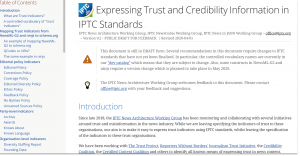
After a lot of drafting work over several years, we released the Guidelines for Expressing Trust and Credibility signals in IPTC standards that shows how to embed trust infiormation in the form of “trust indicators” such as those from The Trust Project into content marked up using IPTC standards such as NewsML-G2 and ninjs. The guideline also discusses how media can be signed using C2PA specification.
We continue to work with C2PA on the underlying specification allowing signed metadata to be added to media content so that it becomes “tamper-evident”. However C2PA specification in its current form does not prescribe where the certificates used for signing should come from. To that end, we have been working with Microsoft, BBC, CBC / Radio Canada and The New York Times on the Steering Committee of Project Origin to create a trust ecosystem for the media industry. Stay tuned for more developments from Project Origin during 2024.
IPTC’s newest standard: IPTC Sport Schema
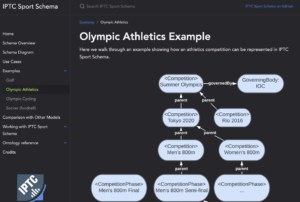
After years of work, the IPTC Sports Content Working Group released version 1.0 of IPTC Sport Schema. IPTC Sport Schema takes the experience of IPTC’s 10+ years of maintaining the XML-based SportsML standard and applies it to the world of the semantic web, knowledge graphs and linked data.
Paul Kelly, Lead of the IPTC Sports Content Working Group, presented IPTC Sport Schema to the world’s top sports media technologists: IPTC Sport Schema launched at Sports Video Group Content Management Forum.
Take a look at out dedicated site https://sportschema.org/ to see how it works, look at some demonstration data and try out a query engine to explore the data.
If you’re interested in using IPTC Sport Schema as the basis for sports data at your organisation, please let us know. We would be very happy to help you to get started.
Standard and Working Group updates
- Our IPTC NewsCodes vocabularies had two big updates, the NewsCodes 2023-Q1 update and the NewsCodes Q3 2023 update. For our main subject taxonomy Media Topics, over the year we added 12 new concepts, retired 73 under-used terms, and modified 158 terms to make their labels and/or descriptions easier to understand. We also added or updated vocabularies such as Digital Source Type and Authority Status.
- The News in JSON Working Group released ninjs 2.1 and ninjs 1.5 in parallel, so that people who cannot move from the 1.x schema can still get the benefits of new additions. The group is currently working on adding events and planning items to ninjs based on requirements the DPP Live Production Exchange project: expect to see something released in 2024.
- NewsML-G2 2.32 and NewsML-G2 v2.33 were released this year, including support for Generative AI via the Digital Source Type vocabulary.
- The IPTC Photo Metadata Standard 2023.1 allows rightsholders to express whether or not they are willing to allow their content to be indexed by search engines and data mining crawlers, and whether the content can be used as training data for Generative AI. This work was done in partnership with the PLUS Coalition. We also updated the IPTC Photo Metadata Mapping Guidelines to accommodate Exif 3.0.
- Through discussions and workshops at our Member Meetings in 2022 and 2023, we have been working on making RightsML easier to use and easier to understand. Stay tuned for more news on RightsML in 2024.
- Video Metadata Hub 1.5 adds the same properties to allow content to be excluded from generative AI training data sets. We have also updated the Video Metadata Hub Generator tool to generate C2PA-compliant metadata “assertions”.
New faces at IPTC
Ian Young of Alamy / PA Media Group stepped up to become the lead of the News in JSON Working Group, taking over from Johan Lindgren of TT who is winding down his duties but still contributes to the group.
We welcomed Bonnier News, Newsbridge, Arqiva, the Australian Broadcasting Corporation and Neuwo.ai as new IPTC members, plus a very well known name who will be joining at the start of 2024. We’re very happy to have you all as members!
We are always happy to work with more organisations in the media and related industries. If you would like to talk to us about joining IPTC, please complete our membership enquiry form.
Here’s to a great 2024!
Thanks to everyone who gave IPTC your support, and we look forward to working with you in the coming year.
If you have any questions or comments (and especially if you would like to speak at one of our events in 2024!), you can contact us via our contact form.
Best wishes,
Brendan Quinn
Managing Director, IPTC
and the IPTC Board of Directors: Dave Compton (LSE Group), Heather Edwards (The Associated Press), Paul Harman (Bloomberg LP), Gerald Innerwinkler (APA), Philippe Mougin (Agence France-Presse), Jennifer Parrucci (The New York Times), Robert Schmidt-Nia of DATAGROUP (Chair of the Board), Guowei Wu (Xinhua)
Categories
Archives
- December 2025
- November 2025
- October 2025
- September 2025
- August 2025
- July 2025
- June 2025
- May 2025
- April 2025
- March 2025
- February 2025
- January 2025
- December 2024
- November 2024
- October 2024
- September 2024
- August 2024
- July 2024
- June 2024
- May 2024
- April 2024
- March 2024
- February 2024
- December 2023
- November 2023
- October 2023
- September 2023
- August 2023
- July 2023
- June 2023
- May 2023
- March 2023
- February 2023
- January 2023
- December 2022
- November 2022
- October 2022
- September 2022
- August 2022
- July 2022
- June 2022
- May 2022
- April 2022
- March 2022
- February 2022
- January 2022
- December 2021
- November 2021
- October 2021
- September 2021
- August 2021
- July 2021
- June 2021
- May 2021
- April 2021
- February 2021
- December 2020
- November 2020
- October 2020
- September 2020
- August 2020
- July 2020
- June 2020
- May 2020
- April 2020
- March 2020
- February 2020
- December 2019
- November 2019
- October 2019
- September 2019
- July 2019
- June 2019
- May 2019
- April 2019
- February 2019
- November 2018
- October 2018
- September 2018
- August 2018
- July 2018
- June 2018
- May 2018
- April 2018
- March 2018
- January 2018
- November 2017
- October 2017
- September 2017
- August 2017
- June 2017
- May 2017
- April 2017
- December 2016
- November 2016
- October 2016
- September 2016
- August 2016
- July 2016
- June 2016
- May 2016
- April 2016
- February 2016
- January 2016
- December 2015
- November 2015
- October 2015
- September 2015
- June 2015
- April 2015
- March 2015
- February 2015
- November 2014

![Preserving metadata tags for AI-generated images in Merchant Center
February 2024
If you’re using AI-generated images in Merchant Center, Google requires that you preserve any metadata tags which indicate that the image was created using generative AI in the original image file.
Don't remove embedded metadata tags such as trainedAlgorithmicMedia from such images. All AI-generated images must contain the IPTC DigitalSourceType trainedAlgorithmicMedia tag. Learn more about IPTC photo metadata.
These requirements apply to the following image attributes in Merchant Center Classic and Merchant Center Next:
Image link [image_link]
Additional image link [additional_image_link]
Lifestyle image link [lifestyle_image_link]
Learn more about product data specifications.](https://iptc.org/wp-content/uploads/2024/02/Screenshot-2024-02-20-at-09.56.52-1024x724.png)